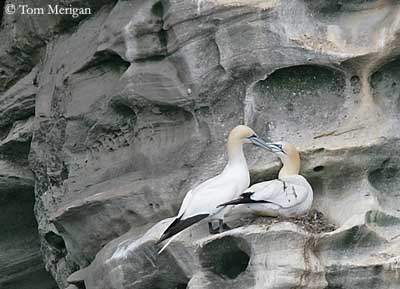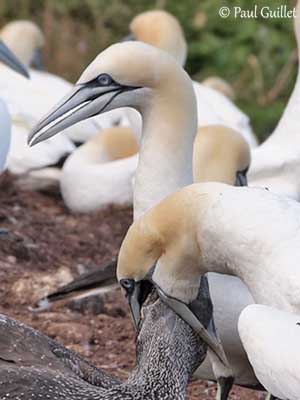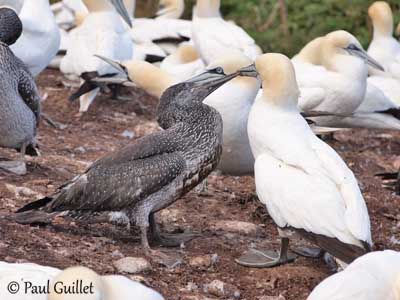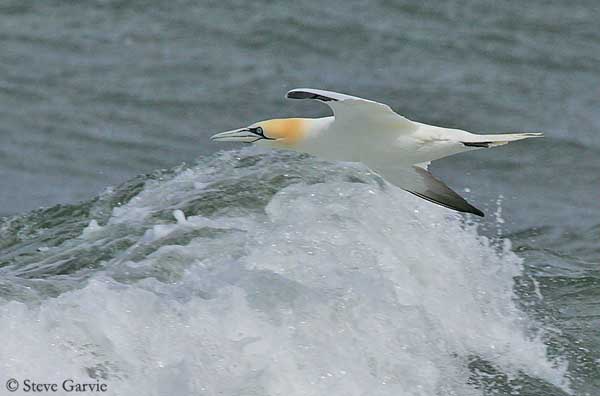
Northern Gannet
Morus bassanus
Suliformes Order – Sulidae Family
PROTECTION / THREATS / STATUS:
Northern Gannet populations have increased and recovered good numbers which seem to be relatively regular today.
Oil pollution is a big threat for all the seabirds, and unfortunately, we can remember several disasters in the past, with thousands of dead birds.
Fr: Fou de Bassan
All : Basstölpel
Esp : Alcatraz Atlántico
Ital : Sula bassana
Nd : Jan-van-gent
Russe : Северная олуша
Sd : Havssula
Photographers :
Steve Garvie
RAINBIRDER Photo galleries
Paul Guillet
Photos d'Oiseaux
René Lortie :
http://rlortie.ca/
Tom Merigan :
Tom Meriganís Photo Galleries
Text by Nicole Bouglouan
Sources:
HANDBOOK OF THE BIRDS OF THE WORLD vol 1 by Josep del Hoyo-Andrew Elliot-Jordi Sargatal - Lynx Edicions - ISBN: 8487334105
THE HANDBOOK OF BIRD IDENTIFICATION FOR EUROPE AND THE WESTERN PALEARCTIC by Mark Beaman, Steve Madge - C.Helm - ISBN: 0713639601
L’ENCYCLOPEDIE MONDIALE DES OISEAUX - Dr Christopher M. Perrins - BORDAS - ISBN: 2040185607
Wikipedia (Wikipedia, The Free Encyclopedia)

BIOMETRICS:
Length : 87-100 cm
Wingspan : 165-180 cm
Weight : 2,3 – 3,6 kg
LONGEVITY: Up to 25 years in wild, sometimes up to 40 years
DESCRIPTION:
The Northern Gannet is the largest member of the Sulidae Family.
Adult has white body plumage, except on head and wing-tips.
The long, pointed wings show black triangle-shaped patch at tip. White tail is pointed too.
Head and nape are yellowish-buff, brighter in male. These colours become paler in late summer and autumn.
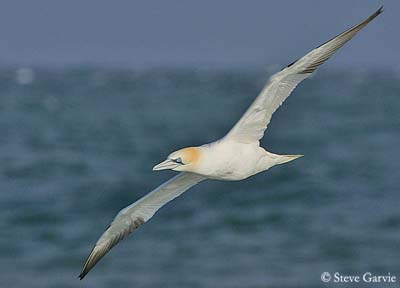
The long, pointed bill is pale blue. Eyes are white, surrounded by pale blue eye-ring and black line. Lores are black. Legs and webbed feet are black.
Both adults are similar.
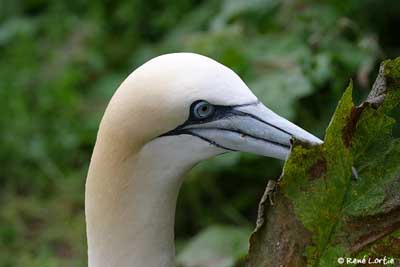
Juvenile is dark brown, spotted white, with white rump. It needs about four years to get the complete adult plumage.
The plumage of immature birds is black and white, more or less heavily spotted black while growing.
The chick is covered with thick white down. It has black eyes and bill.
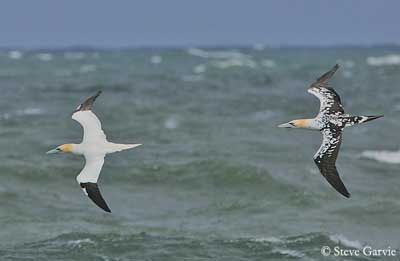
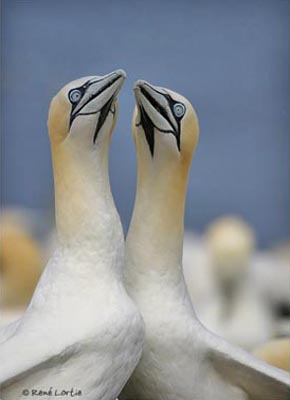
VOICE:
The Northern Gannet is very vocal at colonies and when feeding in flocks. They utter loud, raucous calls. Both male and female utter harsh sounds when they feed at rich food sources. We can also hear a rasping call “arrah-arrah” when arriving at nest, and some grunts.
During the displays, and mainly during the “sky-pointing” display, they utter a kind of sighing “oo-ah”.
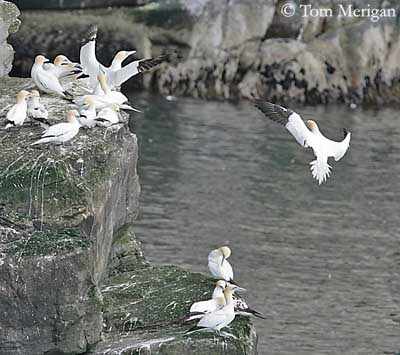
HABITAT:
Northern Gannet is strictly marine outside the breeding season.
It nests on sea-cliffs, mainly on rocky islets and small islands, and sometimes, but rarely on mainland coasts.
RANGE:
Northern Gannet breeds in both sides of North Atlantic. They winter southwards, sometimes reaching equator.
BEHAVIOUR:
Northern Gannet is pelagic and feeds at sea. They are well known for their amazing “plunge-diving” often from great heights, about 10 to 30 metres, sometimes higher.
These birds have peculiar adaptation to this behaviour, with very well developed air-sacs, in order to minimize the impact when they crash into the water.
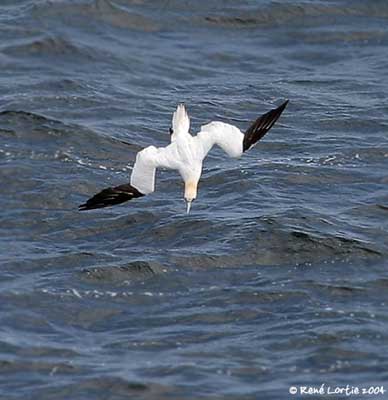
Gannets often forage in groups. The dive is very spectacular. When the shoal is selected, the bird adjusts the direction, taking up position with wide open wings above the water. Then, it descends, and towards the end of the dive, the wings are bent parallel to the body. Finally, it thrusts the wings back in order to touch the water like an arrow.
When they fish in large numbers, they look like a snow-fall…
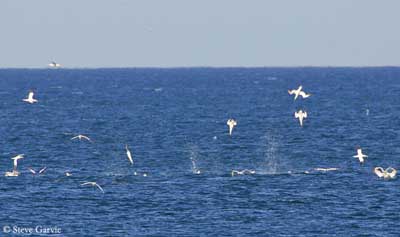
The Northern Gannet may dive up to 10 metres depth. Then, it may use the wings to descend more, up to 15 metres, sometimes 25 metres. The prey is caught and usually swallowed under water, in order to avoid harassment by other seabirds.
Northern Gannet performs courtship displays with often ritualized postures. The most typical display is the “sky-pointing” with neck, head and bill held upwards. Both mates touch their bills and sometimes shake their heads to communicate.
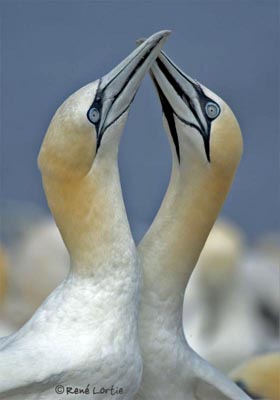
Other postures may be used for threat in territorial disputes, but strong physical contacts are avoided, due to the danger of falling from the cliff ledges. These postures are used as signals towards the other birds in defence of the small nest-site and territory.
Pair-bonds last all the life and pairs return to the same nesting area each year.
Northern Gannet breeds in huge colonies on cliffs. After the breeding season, the adults perform dispersion and move southwards for wintering.
Young birds migrate southwards too, but more extensively than adults.
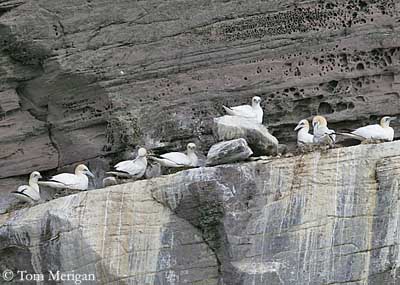

FLIGHT:
Northern Gannet is highly aerial and performs powerful flight. In this species, the flight feathers are moulted almost continuously except during the breeding season.
The Gannet needs to fly all year round for feeding, and this kind of moult avoids long period of incapacity.
REPRODUCTION:
Breeding season occurs in March-April.
Northern Gannet breeds in huge colonies on sea-cliffs. The nest is on the ground. The nest-site is about one square metre in size. These colonies are very noisy.
The nest is large, made with several vegetal items such as grass and seaweed, but also with earth. All the materials are stuck together by excreta.
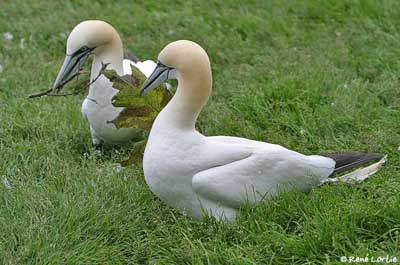
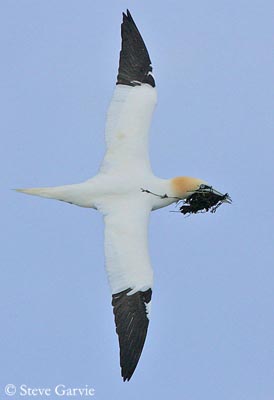
Female lays a single egg of about 8 x 5 mm in size. Incubation by both parents lasts 44 days. Northern Gannet has not brood patch and incubates the egg with its webbed feet. That is for this reason that the eggshell is very thick in order to support the adult’s weight.
At hatching, the chick is near-naked and brooded for the first days. Then, it is covered in white down on the black skin.
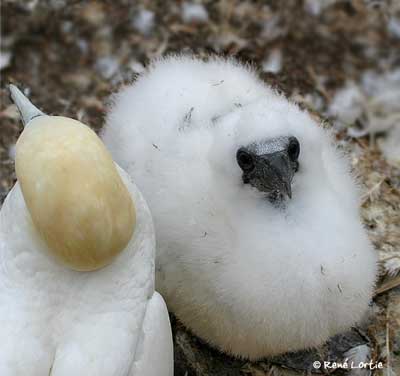
The young fledge three months after hatching. It reaches its sexual maturity at 4-5 years.
Both parents feed the chick. The young bird takes the food directly from the adult’s mouth or even into the throat.
They produce one brood per year.
DIET:
Northern Gannet feeds mainly on fish such as herring, mackerel, sprat and sandheel. The bird performs spectacular plunge-diving into the shoal and takes its prey while going up again. We can see large flocks at rich food sources.
